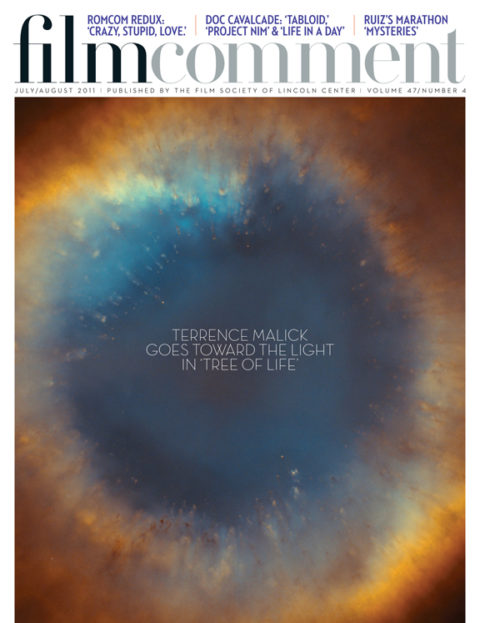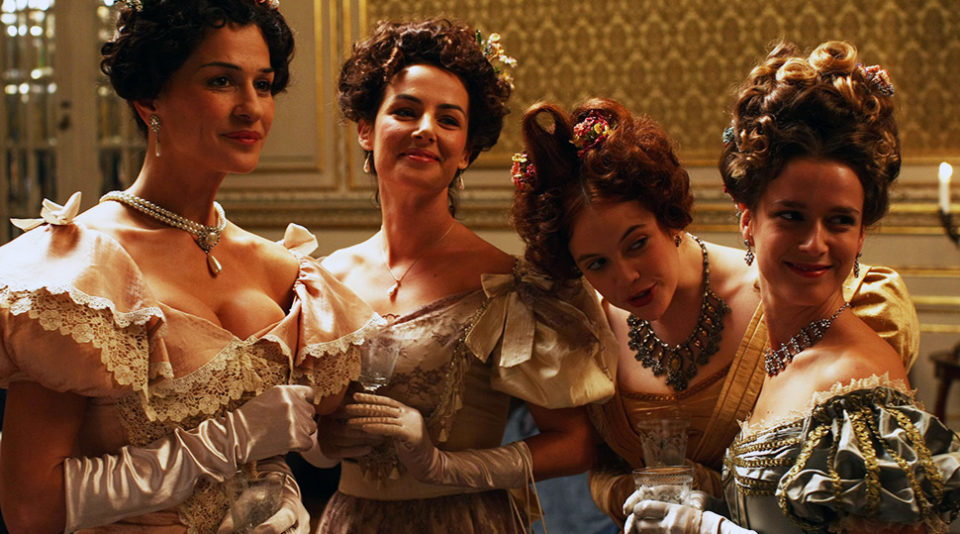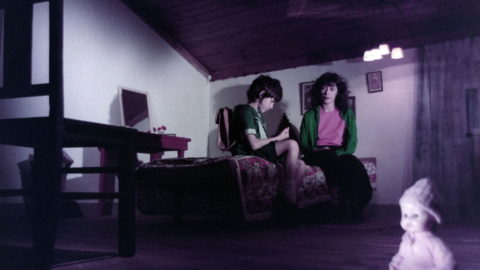By Tony Pipolo in the July-August 2011 Issue

Balancing Act
Poised between detachment and engagement and spinning stories within stories of thwarted love and maternal desertion, Mysteries of Lisbon is equal parts human comedy and fever dream
A magisterial meditation on narrative and cinema, Mysteries of Lisbon is the most glorious achievement of Raúl Ruiz’s prodigious career and one of the first cinematic masterpieces of this century. Based on the multivolume work (untranslated into English) by 19th-century Portuguese novelist Camilo Castelo Branco, the four-and-a-half-hour film whets the appetite for its original six-hour incarnation for Portuguese television. Less starstruck and more satisfying than Time Regained (99), Ruiz’s take on Proust, Mysteries immerses us in the unbounded pleasures of plot, character, action, and intrigue, replete with a lyrical score and grounded in a myriad of vibrant performances.

From the July-August 2011 Issue
Also in this issue
But the film is also imbued with an ironic spirit and authorial consciousness typical of Ruiz. The camera moves incessantly, passing through walls, assuming the pose of an eavesdropper, or impishly blocking our view of an action it deems trivial—strategies familiar in the director’s oeuvre but never more resonant or stirring. Both romantic and modernist, Mysteries is driven by what Ruiz calls (in his 2007 study Poetics of Cinema 2) the complementary strategies of detachment and involvement. In the hands of a master at the top of his game, we are instructed in the arts of narrative and cinematic invention even as we succumb to their seductions.
To recount the plot of the film is to engage with its reflexivity, as each story stumbles into another and points of view shift in a continual spiral that is less a matter of digressions than the irresistible lure of storytelling. Were the film to continue for 50 or 100 hours, one imagines it might subsume all possible stories from the period of its setting—late 18th- to mid-19th-century Portugal and France—into a tapestry threatening to extend geographically with Borgesian design, a human comedy to surpass Balzac’s.

While the film revels in this multilayered fictional world, its preface, presumably from Branco’s original, disavows fabrication: “This story is not my child nor my godchild. It is not a work of fiction; it is a diary of suffering…” Indeed, as each story unfolds in painstaking detail to meet a prior one or anticipate a later one, we discern, in the amassing of coincidences and incidents, the debilitating weaknesses of human nature, the persistent question of parentage, and the dire effects of class structure and maternal abandonment. As in Doomed Love, the only Branco novel translated into English (filmed by Manoel de Oliveira in 1979), romantic relationships are either thwarted or disastrous—a depressing realization, somehow overshadowed by the enthralling nature of this chronicle.
As suggested by the film’s scope, no single point of view dominates. The first-person framing narrative of Pedro da Silva (who is called João at first) yields for long stretches to other stories, which recount circumstances that have affected his life: his illegitimate birth, the doomed love affair of his parents (Angela de Lima and Don Pedro da Silva), the murder of his father, his rescue from being drowned, and the disastrous marriage forced on his mother. Raised by Father Dinis, the priest who bargained for the child’s life (while disguised as a gypsy) with his father’s assassin “Knife Eater,” Pedro is reunited with his mother in adolescence, only to lose her again when, stricken with remorse after her husband’s death, she enters a convent. Ironically, Knife Eater, having since refashioned himself as businessman Alberto de Magalhaes, tries to help the now adult Pedro monetarily, but the latter has sworn to avenge Elisa de Montfort, Alberto’s former lover. Humiliated by an aborted duel and despondent over his mother’s death, Pedro sails away to Tangier, then to Brazil where he falls ill and dictates his life story to a servant.
Ironies are piled upon ironies while the theme of maternal abandonment is constant. Father Dinis learns that his own mother died in childbirth and that his father entrusted him to a friend before entering the religious life. In fact, the Friar Baltasar who tells him all this is . . . his father. And in recounting the tragedy that befell the mother Elisa never knew, Dinis fails to add that this Blanche de Montfort, whom he loved, died in his arms. Unwittingly, Elisa voices the sentiment that bluntly poses the entire question of absent mothers when she wonders if it were not such events that made her own life so miserable.

As even this sketchy outline hints, the ironies and complexities of this narrative move well past six degrees of separation to a metaphysical view of the world. A devout Catholic, Branco believed in sin, redemption, and an omniscient God—ideas that weave through the film via Father Dinis, whose wisdom and insight are trifles compared to the presumably divine gift of bi-location that allows him to materialize everywhere and intervene in everyone’s lives. His sudden appearances and vanishings are miraculously—and wittily—announced by the camera, which tracks back or reframes to the right or left to reveal his presence when we had no idea he was remotely in the vicinity. Both witness and mediator, Father Dinis is the only character summoned by the camera—a deus ex machina of Christian pedigree.
If this reading accords with Branco’s religious convictions, Ruiz’s stance, while respectful of his source, is more wryly poised. The very interventions that seem supernaturally motivated also sustain the narrative and keep the action and characters alive. Clearly, Ruiz admires the fabulous design of Branco’s novel, which “happens” to underscore the author’s belief in divine order. Then again, in the spirit of the balance between detachment and involvement, perhaps Ruiz fluctuates between faith and irony. He stated in a radio interview with Michel Ciment that “distancing” did not imply for him what it did for Brecht.
A scene exposing the behavior of the aristocracy while avoiding reduction to sociopolitical critique demonstrates this. During a furious argument between Pedro’s mother, Angela, and her husband, the Count of Santa Barbara, while her rival Eugénia listens nearby, the camera passes from room to room, as if desperate not to miss anything while seeking a safe exit. Its lateral movement tends to flatten the depth of field, creating a theatrical aura. But more importantly, the effect triggers what Ruiz, in another context, calls “intense detachment,” designed to awaken the analytic faculty even as it arouses emotion. The scene is the product of a triple perspective, all mirrored by the treatment: Father Dinis’s omniscience (the camera’s distance), the hell of Angela’s marriage (the action itself), and Pedro’s conjuring an unwitnessed scene that both compels and frightens him (the camera’s gaze vs. its flight). Beyond reflexivity, the strategy of “intense detachment” fosters the viewer’s deeper involvement on all levels—a layered perspective altogether suited to the embedded nature of a fiction constructed by stories within stories.

This differs from an overtly reflexive scene of Ruiz’s invention. In a room displaying the costumes of Father Dinis’s various guises, as well as his mother’s skull, the priest, scanning these memento mori, says, “And now, my friends, let’s talk,” to which the camera responds with a 360-degree track around him. While I prefer the less literal touch—amusingly symbolized by a nervous tic of the Count whereby his tongue repeatedly pushes against his inner cheek—the scene does suggest a shadowy, even demonic, side to Father Dinis. His brusque chastising of João/Pedro for invading his secret chamber resonates with the Old Testament God’s proscription against eating from the Tree of Knowledge, as the well-preserved garb of his other identities hints at a Manichean quality to his interventions. Such notions are contradicted, however, by Father Dinis’s life as a young man in France (under the name Sebastiao de Melo) and the circumstances that led him, like his father before him, to renounce worldly love and to become the ripest candidate in Branco’s theology for the role of divine emissary.
Father Dinis’s counterpart is ex-assassin Alberto, a man of sensuality and violence, but also of an integrity that belies his origins. Repelled by the hypocrisy of the nobility, he defends Angela against gossip and belittles duels of dubious honor. Only when his baser instincts are aroused, as when he throttles the maleficent Elisa, does Father Dinis again call him Knife Eater, his name when they made the deal that launches the narrative. As men of multiple identities, they recognize each other years later—thanks to Alberto’s telltale belch—as compadres in the human comedy playing opposing but complementary roles.
Ruiz’s direction of actors is an underrated measure of his skillful lacing of engagement with irony. While the performances are uniformly excellent, a few seem uncannily right. In a manner both blunt and understated, Adriano Luz’s Father Dinis commands with a warm, world-weary voice, free of unctuousness or sentimentality. The brooding and industrious Alberto—Lord Byron as capitalist—is embodied in Ricardo Pereira’s physical bearing, an artful blend of animal magnetism and courtly grace, his every move at once furtive and forthright.

Among the film’s pleasures are the sounds, hues, and intonations of spoken Portuguese, so sensuously articulated that even a non-speaker listens attentively. Matching its appeal is the pristine cinematography of André Szankowski, in which lighting and shadows shape mood without melodrama, and colors are neither tritely decorative nor overripe. Shot with what Ruiz calls the “mythical Genesis,” a digital camera compatible with almost any film lens—and capable of registering a depth of field comparable to 35mm—the brilliance and clarity of the images, in both long-shot exteriors and deep-focus interiors, articulate the spatial relationships essential to that rhythm between involvement and detachment.
As the narrative approaches closure, this balance courts a few ambiguities. When Pedro shoots himself after the aborted duel with Alberto, the story continues as if he had not. As he lies ill far from Lisbon, the toy theater from his childhood is to the left of his bed. In the Ciment interview, Ruiz dismisses the prop as a ploy to save time and footage, but it resonates powerfully as a teatro mundi. The cardboard sets and figures appear more than half a dozen times before key events in the child’s life, prefiguring the action to come—suggesting the preordained nature of all things even as they serve as a reflexive trope. When his mother leaves him for the convent, the boy angrily knocks over the figures as only a first-person narrator can do.
His gesture follows a shot alluding to a classic moment of maternal abandonment: the cabin scene in Citizen Kane. Ruiz reverses the deep-focus shot in which Charles is seen through a window playing in the snow as his mother sits in the foreground signing his life away to Thatcher. In Mysteries, as mother and guardian, framed by a window, decide João’s fate, the boy, close up in the foreground, looks at the camera and mouths their words. This look and address suggest a fusion—or confusion—of first-person and omniscient narrators, and not only because, unlike Kane, it is the older Pedro who reviews the memory. Mysteries of Lisbon is that rare film that incites serious reflection on the logic and limits of first-person point of view in narrative cinema. The ramifications of this may explain Ruiz’s addiction to stories within stories, which, apart from whatever pleasures such narratives provide, give proof to the simple truth that no story can avoid overlapping with others, that no individual point of view can possibly tell the whole story.

In the final scene, Pedro revisits an early memory in which, in a feverish state, possibly following an epileptic fit, he was attended by a woman he did not yet know was his mother. The image is optically distorted, the figures wavering in an unstable space from the boy’s dizzying perspective. (In Ruiz’s 2000 film Comedy of Innocence, the same kind of distortion expresses a child’s confusion about the identity of his mother.) The replay of Pedro’s memory is transformed into a vision of undivided maternal love that he can only fleetingly imagine. Scanning the hallucinatory image, the camera excludes everything from the frame but mother and child, embracing them in an iconic but fragile moment before they bleed into a dazzling light that fades into the white of the screen.
It is Ruiz’s deftest, if cruelest, touch: an image of consummate beauty and devastating loss in an ambiguous context. But even if the film is the feverish dream of an exceedingly imaginative child, the final shot implies that, however long and intricate our lives, they often crystallize, like narratives, into a single fixated image. Detachment, Ruiz has said, allows us to “understand the process of falling in love with a work of art.” What should we “understand” here? Is the primal image of a longed-for mother too archaic for contemporary viewers? And does detachment soften the blow of its wrenching effect? I doubt Branco left his readers with such questions. Perhaps even Father Dinis, who complains of the burden of “knowing too much,” would throw up his hands and say, “God only knows.”
Tony Pipolo is the author of Robert Bresson: A Passion for Film (Oxford) and a psychoanalyst in private practice.







